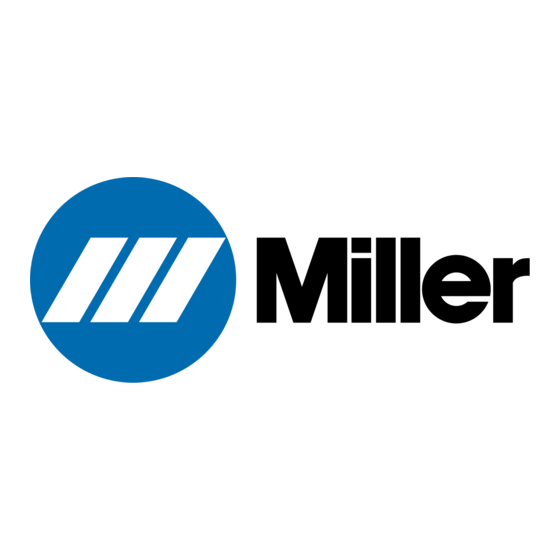Miller 819A Podręcznik techniczny - Strona 3
Przeglądaj online lub pobierz pdf Podręcznik techniczny dla Przenośny generator Miller 819A. Miller 819A 44 stron.

SECTION 1 − SAFETY PRECAUTIONS FOR SERVICING
Protect yourself and others from injury — read, follow, and save these important safety precautions and operating instructions.
1-1. Symbol Usage
DANGER! − Indicates a hazardous situation which, if
not avoided, will result in death or serious injury. The
possible hazards are shown in the adjoining symbols
or explained in the text.
Indicates a hazardous situation which, if not avoided,
could result in death or serious injury. The possible
hazards are shown in the adjoining symbols or ex-
plained in the text.
NOTICE − Indicates statements not related to personal injury.
1-2. Servicing Hazards
The symbols shown below are used throughout this manual
to call attention to and identify possible hazards. When you
see the symbol, watch out, and follow the related instructions
to avoid the hazard.
Only qualified persons should test, maintain, and repair this
unit.
During servicing, keep everybody, especially children, away.
ELECTRIC SHOCK can kill.
D Do not touch live electrical parts.
D Stop engine and remove input power plug from
receptacle (if applicable) before testing or re-
pairing unit unless the procedure specifically
requires an energized unit.
D Insulate yourself from ground by standing or working on dry insu-
lating mats big enough to prevent contact with the ground.
D Do not leave live unit unattended.
D If this procedure requires an energized unit, have only personnel
familiar with and following standard safety practices do the job.
D When testing live unit, use the one-hand method. Do not put both
hands inside unit. Keep one hand free.
SIGNIFICANT DC VOLTAGE exists in inverter power
sources AFTER stopping engine.
D Stop engine on inverter and discharge input capacitors according
to instructions in Troubleshooting Section before touching any
parts.
MOVING PARTS can injure.
D Keep away from moving parts such as fans,
belts, and rotors.
D Keep away from pinch points such as drive
rolls.
D Have only qualified people remove doors,
panels, covers, or guards for maintenance
and troubleshooting as necessary.
D Keep hands, hair, loose clothing, and tools
away from moving parts.
D Before working on generator, remove spark plugs or injectors
to keep engine from kicking back or starting.
D Block flywheel so that it will not turn while working on genera-
tor components.
D Reinstall doors, panels, covers, or guards when servicing is
finished and before starting engine.
Belt Drive Generator
.
Indicates special instructions.
This group of symbols means Warning! Watch Out! ELECTRIC
SHOCK, MOVING PARTS, and HOT PARTS hazards. Consult sym-
bols and related instructions below for necessary actions to avoid the
hazards.
FLYING METAL or DIRT can injure eyes.
D Wear safety glasses with side shields or face
shield during servicing.
D Be careful not to short metal tools, parts, or
wires together during testing and servicing.
STATIC (ESD) can damage PC boards.
D Put on grounded wrist strap BEFORE handling
boards or parts.
D Use proper static-proof bags and boxes to
store, move, or ship PC boards.
Using a generator indoors CAN KILL
YOU IN MINUTES.
D Generator exhaust contains carbon monoxide.
This is a poison you cannot see or smell.
D NEVER use inside a home or garage, EVEN IF
doors and windows are open.
D Only use OUTSIDE and far away from windows, doors, and
vents.
FUEL can cause fire or explosion.
D Stop engine and let it cool off before checking or
adding fuel.
D Do not add fuel while smoking or if unit is near
any sparks or open flames.
D Do not overfill tank; clean up any spilled fuel.
FIRE OR EXPLOSION hazard.
D Do not place unit on, over, or near combustible surfaces.
D Do not service unit near flammables.
BATTERY EXPLOSION can BLIND.
D Always wear a face shield, rubber gloves, and
protective clothing when working on a battery.
D Stop engine before disconnecting or connect-
ing battery cables.
D Do not allow tools to cause sparks when working on a battery.
D Do not use welder to charge batteries or jump start vehicles.
D Observe correct polarity (+ and −) on batteries.
D Disconnect negative (−) cable first and connect it last.
BATTERY ACID can BURN SKIN and EYES.
D Do not tip battery.
D Replace damaged battery.
D Flush eyes and skin immediately with water.
OM-268 819A - 2014−06, safety_rtm 2013-09
TM-268 819 Page 1
